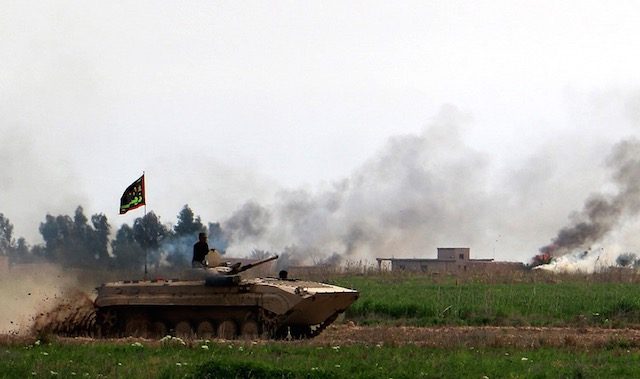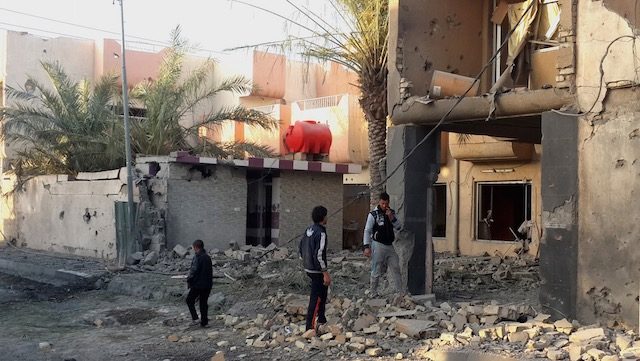SUMMARY
This is AI generated summarization, which may have errors. For context, always refer to the full article.

TIKRIT, Iraq – Iraqi forces entered Tikrit Wednesday, March 11, dodging bombs and sniper fire in search of their biggest victory yet against embattled jihadists who tried to light new fires elsewhere in Iraq and Syria.
The Islamic State (ISIS) group has suffered stinging defeats in the heart of its self-proclaimed “caliphate” recently, but its ultraviolent ideology has inspired attacks and recruits globally.
With ISIS brutality and population displacement reaching new highs, Washington sought increased powers from the US Congress to take on a group threatening to reshape the Middle East.
However, it was without direct support from the US-led coalition’s air campaign that Iraqi government and allied forces punched into parts of Tikrit, marking a new phase in a 10-day drive to wrest the city back from ISIS.
A combination of army, police and volunteer forces moved into northern and southern Tikrit, the hometown of former Iraqi president Saddam Hussein and a main ISIS stronghold.
A major general told Agence France-Presse on condition of anonymity that government forces were battling “to cleanse the neighborhood of Qadisiyah” in Tikrit.
“But we are engaging in a very delicate battle because we are not facing fighters on the ground, we are facing booby-trapped terrain and sniper fire. Our movement is slow,” he said.
An army colonel said forces coming from another direction had also retaken the main hospital on the city’s southern edge.
Early in the offensive, in which up to 30,000 men were initially involved while ISIS is believed to have just a few hundred fighters inside Tikrit, most outlying areas were reconquered.
Ramadi bombings
The town of al-Alam, a flashpoint north of Tikrit along the Tigris river, was fully under the control of pro-government fighters and local anti-ISIS Sunni tribesmen Wednesday, an Agence France-Presse reporter there said.
On the back foot in eastern and northern Iraq, ISIS tried to seize the initiative elsewhere, including with a spectacular coordinated attack in Ramadi in the west.
12 car bombs exploded almost simultaneously around the city after dawn, with at least seven suicide bombers targeting government security installations, police said.
At least 17 people were killed and 38 wounded, according to a police lieutenant colonel and a doctor at Ramadi hospital.

Clashes ensued but ISIS failed to gain any ground in one of the biggest attacks against a rare pocket of government control in Anbar.
“Our brave security forces were ready and had excellent intelligence about the operation,” Anbar Governor Sohaib al-Rawi said on social media.
In and around Baghdad on Wednesday, at least 17 people were killed in five attacks, including nine in a car bomb in the Hurriya neighborhood.
Also on the offensive in Syria, the jihadists launched a “huge assault” Wednesday to try to capture a strategic town on the border with Turkey, killing dozens.
Their attack focused on Ras al-Ain and ISIS seized a nearby village, the Syrian Observatory for Human Rights said.
Observatory head Rami Abdel Rahman said the offensive was a preemptive strike against Kurdish militiamen planning to attack the ISIS-held town of Tal Abyad farther west.
At least 12 fighters from the Kurdish People’s Protection Units, which control Ras al-Ain and surrounding villages, were killed, he said.
US unease
ISIS has also ramped up its propaganda war in what some analysts see as a possible sign of desperation by a movement on its last legs.
After destroying several Iraqi heritage sites that are among the planet’s most precious, the jihadists again shocked the world on Tuesday by releasing a video in which an Arab Israeli accused of spying for Israel is “executed” by a boy who looks no older than 12.
Addressing US lawmakers, Secretary of State John Kerry said it was a “pivotal hour” in the battle against the most violent group in the history of modern jihad.
Appearing before the Senate foreign relations committee, he and top US defense officials appealed for a united vote in favor of a new authorization for the use of military force against ISIS.
The United States leads a 60-nation coalition involved in the fight against the jihadists and has carried out hundreds of strikes against IS in Iraq and Syria.
However, the US security establishment has expressed unease at the prominent role played by Iran in the military effort.
“I am made uncomfortable by the fact that it looked like a Shia advance against a Sunni town,” former CIA chief Michael Hayden said Tuesday of the operation to retake Tikrit.
Iran’s top commander for external military operations, Qassem Soleimani, has been ubiquitous on Iraq’s front lines.
Comments by Iranian-backed militia commanders had stoked fears that the recapture of Tikrit could lead to widespread sectarian reprisal killings.
But so far, reports of abuses by the mostly Shiite Iraqi forces battling ISIS in and around Tikrit have been relatively limited. – Ahmad al-Rubaye with Marwan Ibrahim in Kirkuk, AFP / Rappler.com
Add a comment
How does this make you feel?
There are no comments yet. Add your comment to start the conversation.